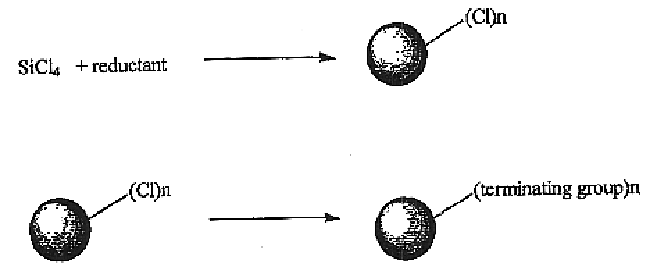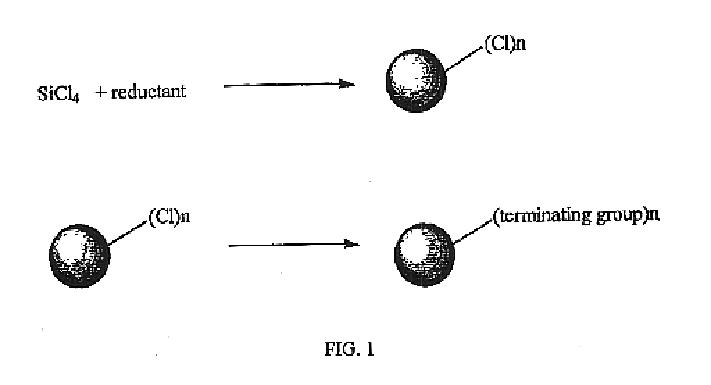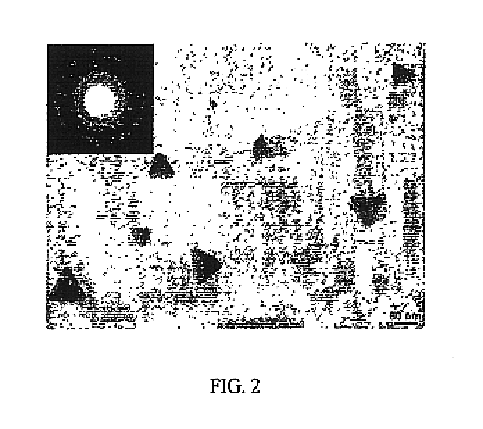High yield method for preparing silicon nanocrystals with chemically accessible surfaces
a technology of silicon nanocrystals and high yield, applied in the direction of crystal growth process, polycrystalline material growth, silicon compounds, etc., can solve the problems of nanocrystalline silicon utilization, lack of high yield synthetic method, surface oxide contamination,
- Summary
- Abstract
- Description
- Claims
- Application Information
AI Technical Summary
Benefits of technology
Problems solved by technology
Method used
Image
Examples
example 1
[0038]A tetrahydrofuran solution of sodium naphthalenide (0.9 g, 39 mmol Na and 3.23 g, 25 mmol of naphthalene in 30 cm3 tetrahydrofuran stirred for three hours) was added rapidly at room temperature via cannula to a 500 cm3 Schlenk flask containing 300 cm3 of 1,2-dimethoxyethane and 1.14 g, 6.7 mmol of SiCl4 with rapid stirring. On completion of the naphthalenide addition a large excess of n-butyllithium (10 cm3, 1.6M in hexane) was added immediately. The solvent was removed under vacuum from the resulting yellow brown suspension. The residue was extracted with hexane and washed with water to remove sodium and lithium salts. Evaporation of the hexane layer followed by heating under vacuum to remove residual naphthalene gave 0.7 g of a viscous yellow oil.
[0039]Transmission electron microscopy (TEM) shows the presence of crystalline silicon tetrahedra of approximately 60 nm in edge length. The bright-field TEM image of a number of the silicon nanocrystals on a holey carbon grid, alon...
example 2
[0041]Sodium naphthalenide, prepared from sodium (0.69 g) and nanphthalene (2.39 g) stirred in 70 cm3 of 1,2-dimethoxyethane overnight, was added rapidly via cannula to a stirred solution of 1.04 g of SiCl4 in 1,2-dimethoxyethane. The dark brown suspension obtained was stirred for a further 30 minutes then 5 cm3 of 1-octanol was added. A yellow solution with a white precipitate was observed immediately. The solvent and naphthalene were removed immediately with heating in a water bath. The resulting orange solid was extracted with hexane and washed three times with slightly acidic distilled water. The hexane layer was collected and pumped down to give a waxy orange hexane soluble solid. Solution 1H NMR was consistent with octanoxide groups on the surface of the nanocrystals. This was also supported by the IR spectrum in which a Si—OR stretch was observed at ˜1080 cm−1 and an alkyl C—H stretch at 3000 cm−1. The nanocrystals
[0042]Holey carbon grids for TEM were prepared by suspending t...
example 3
[0043]Magnesium powder (0.47 g) was suspended with sonication in 70 cm3 of dry 1,2-dimethoxyethane. To this was added 1.18 cm3 of SiCl4 and the resulting suspension sonicated overnight. To the red / brown solution and gray precipitate thus obtained was added 2 cm3 of 20% MgBuCl in tetrahydrofuran. The solvent and any other volatiles were removed under vacuum, the resulting colorless oil taken up in hexane, washed with slightly acidified water and again pumped down to a colorless oil. The oil contained small silicon nanoparticles by TEM (1H NMR and IR confirmed the existence of terminating butyl groups.
PUM
| Property | Measurement | Unit |
|---|---|---|
| length | aaaaa | aaaaa |
| length | aaaaa | aaaaa |
| length | aaaaa | aaaaa |
Abstract
Description
Claims
Application Information
 Login to View More
Login to View More - R&D
- Intellectual Property
- Life Sciences
- Materials
- Tech Scout
- Unparalleled Data Quality
- Higher Quality Content
- 60% Fewer Hallucinations
Browse by: Latest US Patents, China's latest patents, Technical Efficacy Thesaurus, Application Domain, Technology Topic, Popular Technical Reports.
© 2025 PatSnap. All rights reserved.Legal|Privacy policy|Modern Slavery Act Transparency Statement|Sitemap|About US| Contact US: help@patsnap.com



